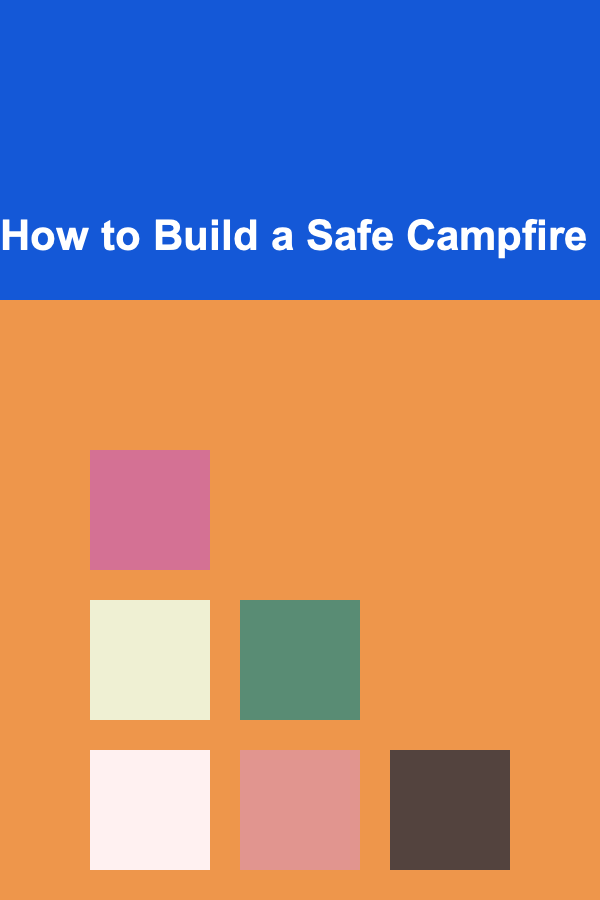
How to Build a Safe Campfire
ebook include PDF & Audio bundle (Micro Guide)
$12.99$10.99
Limited Time Offer! Order within the next:

Building a safe campfire is a fundamental skill for any outdoor enthusiast, whether you're camping, hiking, or simply enjoying the wilderness. A campfire provides warmth, light, and a place to cook, but it also carries risks if not managed properly. A poorly managed fire can lead to accidents, wildfires, or even personal harm. In this comprehensive guide, we will explore the steps for building a safe campfire, safety precautions, and important environmental considerations that help protect nature and ensure the safety of everyone involved.
Choosing the Right Location for a Campfire
The first and most critical step in building a safe campfire is selecting the right location. A safe campfire starts with the right site to minimize the risk of accidental fires.
1.1 Avoid Dry Areas
Choose a campsite that is away from dry grass, fallen leaves, or pine needles, which can catch fire easily. Ideally, the site should be on bare soil or gravel, as these surfaces are less likely to spread fire. Avoid areas that are particularly windy, as wind can easily spread sparks and embers.
1.2 Consider Proximity to Structures
Make sure your campfire is at least 15 feet away from tents, tarps, trees, and any other flammable materials. This distance reduces the risk of the fire spreading to tents or nearby vegetation. It's important to consider the prevailing wind direction when setting up your campfire, as wind can carry embers far from the fire.
1.3 Check Local Regulations
Some campgrounds, national parks, or wilderness areas may have fire bans or specific guidelines for campfires, especially during dry seasons. Always check local regulations before starting a fire. Not adhering to regulations can lead to hefty fines or, worse, start a wildfire.
Gathering the Materials for a Campfire
Once you have found a safe spot, you will need to gather the right materials to build the fire. The key to a successful and controlled campfire lies in using the proper materials and arranging them efficiently.
2.1 Dry Wood
Start by collecting dry, seasoned wood. Wood that has been dried for six months or more burns best because it produces less smoke and is easier to ignite. Avoid using green wood or logs that are wet, as they produce more smoke and are harder to light.
2.2 Tinder
Tinder is the material that will catch fire first, helping to ignite the larger kindling and fuel. Examples of tinder include dry leaves, grass, pine needles, birch bark, or even cotton balls soaked in petroleum jelly. Make sure the tinder is dry; wet or damp tinder will not catch fire easily.
2.3 Kindling
Kindling refers to small sticks or twigs that catch fire from the tinder and help ignite larger logs. Typically, kindling should be about the thickness of a pencil. Having a good amount of kindling is essential for getting the fire started quickly.
2.4 Fuel Wood
Once your tinder and kindling are burning, you will add larger pieces of fuel wood. Fuel wood should be split into manageable logs, not too thick, to ensure the fire burns efficiently and safely. If your fire is too large, it will be harder to control, so it's essential to have a steady supply of fuel but not go overboard.
2.5 Firestarter
If you're worried about starting the fire, you can use a firestarter. These can be commercially purchased, or you can create homemade versions using waxed cotton, dryer lint, or a firestarter kit. These tools are useful in situations where dry tinder and kindling are scarce.
Building the Fire
Once you've gathered the necessary materials, it's time to build the fire. The key to a successful fire is starting small and gradually increasing the size. Here's how to do it:
3.1 The Teepee Method
The teepee method is one of the most popular ways to build a campfire. Start by placing a small bundle of tinder in the center of your fire ring. Then, arrange your kindling around the tinder in a teepee-like shape, leaving enough space for air to circulate. As the kindling catches fire, you can slowly add larger pieces of wood in the same manner. The teepee structure encourages good airflow, which helps the fire burn hotter and faster.
3.2 The Log Cabin Method
This method is similar to the teepee method but with a more structured layout. Begin with a small bundle of tinder in the center, surrounded by kindling in the teepee formation. After your kindling is burning well, build a square "log cabin" shape by placing larger logs around the smaller pile. This method helps control the fire's size and direction and allows for a steady burn.
3.3 The Lean-To Method
The lean-to method is ideal if you're trying to create a fire with limited resources or if it's windy. To use this method, place a long, sturdy stick at a 45-degree angle over your tinder. Lean kindling against the stick in the shape of a lean-to structure. The lean-to method offers protection from the wind and helps concentrate the heat.
3.4 The Star Method
This method is ideal for long-lasting fires with minimal effort. Start by placing your tinder in the center and adding kindling around it in a star shape. As the fire grows, the kindling will radiate outward, and you can add logs around the edges to keep the fire going.
Managing the Fire
Now that your fire is built, it's important to manage it effectively to ensure it burns safely and efficiently. Proper fire management helps maintain control over the flames and reduces the risk of accidents.
4.1 Keep It Small
Always keep your campfire small and manageable. A fire that's too large can get out of control quickly, especially in windy conditions. If the fire becomes too large, consider adding fewer logs or allowing it to burn down before adding more wood.
4.2 Keep Water Nearby
Always have a water source nearby in case the fire spreads unintentionally. You can use a bucket of water, a fire extinguisher, or a shovel to control the flames if needed. Regularly monitor the fire to ensure it doesn't spread beyond the fire ring.
4.3 Don't Leave the Fire Unattended
Never leave your fire unattended. Even a small, seemingly controlled fire can quickly grow out of control if left alone, especially if wind conditions change. Always have an adult or responsible person monitoring the fire at all times.
4.4 Snuffing the Fire
When it's time to put out the fire, do so properly. Never leave a fire smoldering or partially extinguished. The best way to put out a fire is to pour water on it, stir the ashes, and pour more water. Continue until there is no hissing sound or visible smoke. After the fire is out, check for hot spots and ensure that the area is completely cold before leaving.
Environmental Considerations
When building a campfire, it's important to think beyond your immediate safety and consider the environment. Campfires can cause lasting damage to the land if not handled properly.
5.1 Choose Established Fire Rings
Use established fire rings or pits wherever possible to minimize environmental impact. These fire rings are often placed in spots where campfires can be safely managed without damaging the surrounding ecosystem. If no fire ring is available, create a safe fire pit by clearing the area of leaves, grass, and other flammable materials.
5.2 Avoid Damaging the Environment
Always use dead wood and never cut down live trees or branches for firewood. Live trees provide essential habitats for wildlife, and cutting them down for firewood can damage the ecosystem. Stick to dead or fallen wood to minimize your environmental impact.
5.3 Leave No Trace
Once your campfire is out, make sure to clean up all the ashes and remaining debris. Pack out any leftover fire starter materials and make sure that nothing is left behind that could impact the environment. Adhering to the Leave No Trace principles ensures that the next group of campers can enjoy the area as you did.
Fire Safety Essentials
While building a campfire is an enjoyable outdoor activity, it's also crucial to be aware of fire safety principles to prevent accidents.
6.1 Fire Extinguisher
If you're camping in an area where wildfires are a risk, or if you're unsure about the safety of your campfire, it's a good idea to bring a small fire extinguisher or a bucket of sand. This can be used to control the fire if it becomes uncontrollable.
6.2 First Aid Kit
In the event of burns or accidents, always have a well-stocked first aid kit nearby. Familiarize yourself with basic first aid procedures for treating burns and other injuries. Knowing how to respond quickly can prevent injuries from becoming more severe.
Conclusion
Building and managing a safe campfire requires careful preparation, attention to detail, and respect for the environment. By following these guidelines, you can enjoy the warmth, light, and ambiance that a campfire brings while minimizing the risks involved. Always be prepared to put out the fire properly, and remember that safety should be your top priority at all times. Whether you're a seasoned camper or a beginner, learning how to build a safe campfire is an essential skill for your outdoor adventures.

How to Provide Exceptional Customer Support in a Call Center
Read More
How to Reassess and Adjust Your Financial Plan After a Major Life Event
Read More
How to Save Money for Retirement While Paying Off Debt
Read More
How to Use Podcast Editing Skills to Make Money
Read More
How to Make Wire-Wrapped Crystal Pendants
Read More
How to Find Free Camping Spots on Your Road Trip
Read MoreOther Products

How to Provide Exceptional Customer Support in a Call Center
Read More
How to Reassess and Adjust Your Financial Plan After a Major Life Event
Read More
How to Save Money for Retirement While Paying Off Debt
Read More
How to Use Podcast Editing Skills to Make Money
Read More
How to Make Wire-Wrapped Crystal Pendants
Read More